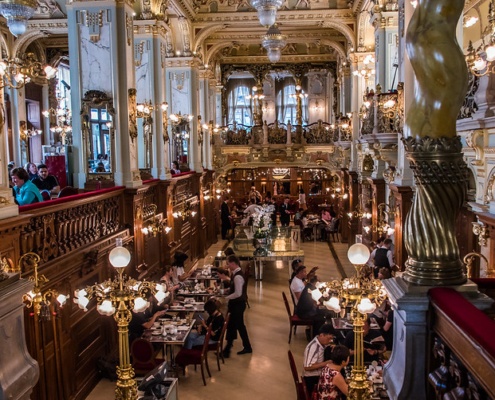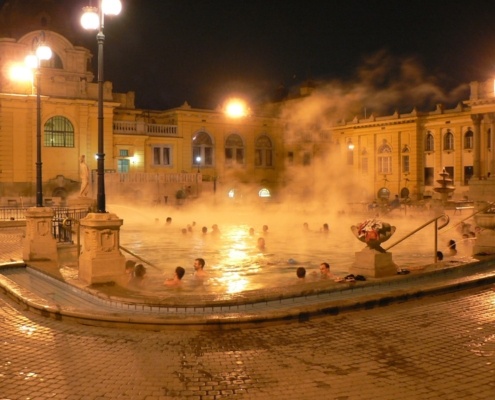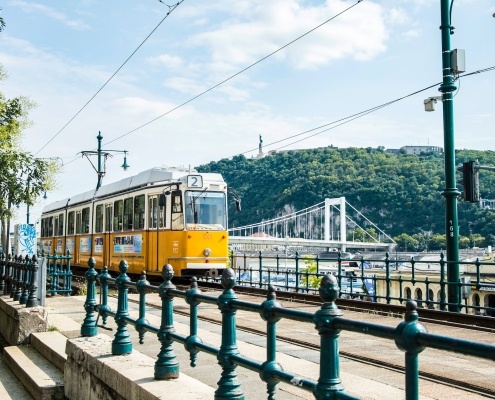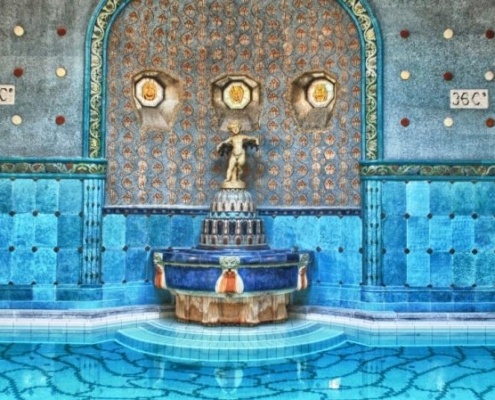Budapest’s Best Playgrounds at Gellért Hill Area
Budapest, the vibrant capital of Hungary, is renowned for its rich history, stunning architecture, and lively culture. Yet, tucked away from the bustling streets and amidst the iconic landmarks lies a treasure trove for families seeking outdoor adventures – the playgrounds nestled in the scenic Gellért Hill area. Offering breathtaking views and innovative play structures, these parks provide an unforgettable experience for both children and parents alike.
Gellért Hill isn’t just a sightseeing spot; it’s a haven for fun and relaxation. Ascend to the summit to marvel at the panoramic views, take a stroll amidst the verdant trees, or unwind with a delightful picnic on one of the shaded lawns. And did you know? There are not just one or two, but 3 playgrounds awaiting discovery on this picturesque hill!
Before embarking on your adventure, be sure to pack a cozy blanket from your Airbnb or hotel, along with some sandwiches and refreshing beverages, as amenities may be limited. Join us as we set out to explore Budapest’s coolest playgrounds and uncover the enchantment they hold.
Slide Park Playground ( Csúszdás játszótér in Hungarian)
This shady playground underwent a complete renovation in 2017. You can easily reach it from Gellért Square (M4 metro, Tram 49, 47, 18, 19, 41, Bus 7). Simply walk up from Gellért Cave Church; it is located just a 3-minute walk from the Cave Church, opposite the entrance to Gellért Thermal Baths on the hillside.
So, what can you expect here? You’ll find wavy, winding, and tube slides, as well as shorter and double slides for the little ones. The location has also been expanded with additional games such as a nest swing, spring rider, seesaw, climbing tunnel, a smaller sandbox equipped with a sun sail, and two sunken trampolines. Thanks to the terrace layout, at the starting point of the slides, you’ll also find a suspension bridge climbing frame and a mini lookout tower. Additionally, there are bike racks and picnic benches available.
Moreover, there is a drinking fountain on the playground, although the toilet is often unfortunately closed. If nature calls, you can head to Gellért Thermal Baths and find the free toilet behind the information point.

Vuk the Little fox playground ( Vuk-os játszótér in Hungarian)
This picturesque playground underwent a complete renovation recently. You can easily reach it from Móricz Zsigmond körtér by bus 27. Get off at Búsuló Juhász stop (Citadel), then walk a little further towards Bérc utca. You will find this playground right on the Szirtes and Bérc street corner.
The theme of this playground is based on our childhood cartoon called “Vuk the Little Fox,” which was created in 1981. It’s not your typical Hollywood children’s story, but it’s a beautiful tale with many great lessons for children. You can find the cartoon trailer in English on YouTube. Therefore, you’ll encounter the majority of the characters at this playground: Vuk the Little Fox, the drunken geese, the frog, the dog, etc.
So what to expect here:
There are climbing slides, swings, spring riders, and a sandbox. The park hides many elements that are considered innovative compared to a traditional playground. Several plastic hide-and-seek elements have been placed, some connecting the top of a small hill with its base, while others form larger tunnel systems leading to a cozy central nook. Climbing up the little hill is just as enjoyable for the little ones as crawling underneath it. Safety was, of course, a priority, hence the green rubber mat covering. Shading has been installed over the sandbox, allowing children to use it even on the hottest summer days. The wooden playhouse is every child’s favorite. For the older preschool age group, a castle equipped with climbing ropes and a climbing wall has been placed. The playground has a drinking fountain and a toilet.
Local knowledge: there is a premium supermarket just outside the playground with a big selection of ice cream, coffee sandwiches, and beer..(but please note: drinking alcoholic beverages and smoking cigarettes are strictly forbidden in any playground.)
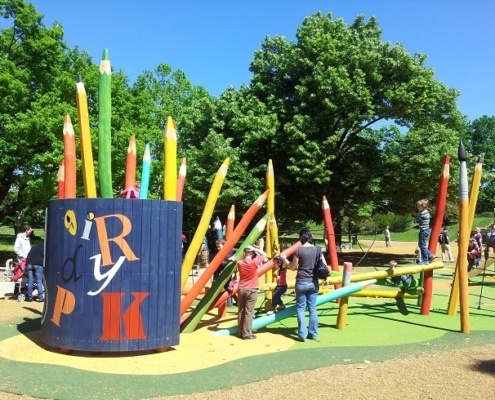
Pen Playground (Ceruzás Játszótér in Hungarian)
This cool playground is relatively new; however, it requires further renovation for some of the play poles. You can easily reach it from Móricz Zsigmond körtér by taking bus 27. Get off at the Búsuló Juhász stop (Citadel), then walk a little further up towards the Citadel. The road leading here is closed to traffic, up to the top of Gellért Hill. If you want to reach here from Slide Park Playground, it’s just a 10-minute uphill walk in a beautiful environment with a view of the Citadel.
The theme of the playground is the many colorful pencils forming the climbing frame. For example, the squirrel wheel is called a pencil sharpener. Unfortunately, some parts of the playground are under renovation at the moment (April 2024), but you can still enjoy nature, walking paths, and views of the Citadel. You’ll also find fun games, such as the sunken trampoline, an interesting solution not seen elsewhere. The area around the games is covered with a thick rubber mat, which is quite soft.
The playground has a drinking fountain, but not a toilet. The nearest paid toilet can be found at the upper parking lot of the Citadel.
Local tip: There is a premium supermarket just a 1-minute walk from the bus stop towards Szirtes Street with a big selection of ice cream, coffee, sandwiches, and beer. (But please note: drinking alcoholic beverages and smoking cigarettes are strictly forbidden in any playground.)
In conclusion, Budapest’s coolest playgrounds at the Gellért Hill area offer an unparalleled experience for families seeking outdoor adventures. From breathtaking views to innovative play structures, these playgrounds are not just for children but for the children in all of us. And what makes them even more special? They were put to the test by none other than the senior free tour guides who have naughty kids themselves. So you can trust that these playgrounds are not only fun but also safe and exciting for the whole family.
Whether you’re ascending to the top of Gellért Hill for the stunning panoramic views, enjoying a leisurely stroll among the trees, or picnicking on one of the shaded lawns, make sure to add a visit to these playgrounds to your itinerary. With their unique themes, such as the colorful pencils at Pen Playground or the characters from “Vuk the Little Fox” at Vuk-os Playground, there’s something for everyone to enjoy.
So pack a blanket, grab some snacks, and embark on an adventure to discover the magic of Budapest’s coolest playgrounds at the Gellért Hill area.
Your inner child will thank you!
For more practical tips from locals, visit our walking tours running every day!

